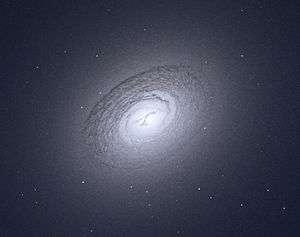NGC 3607
| NGC 3607 | |
|---|---|
 The nuclear dust disk of NGC 3607 as imaged by the Hubble Space Telescope | |
| Observation data (J2000 epoch) | |
| Constellation | Leo |
| Right ascension | 11h 16m 54.6s[1] |
| Declination | +18° 03′ 07″[1] |
| Redshift | 960 ± 20 km/s[1] |
| Apparent magnitude (V) | 10.8[1] |
| Characteristics | |
| Type | SA(s)[1] |
| Apparent size (V) | 4′.9 × 2′.5[1] |
This elliptical galaxy is part of the Leo II Group (NGC 3607 Group) of galaxies.[2] Orbital motions of the globular cluster system[3] imply an unusual poverty of dark matter: perhaps 16±44% of the total mass within 5 effective radii. Recent article shows that its central black hole has a mass of about M• = (1.2 ± 0.4) × 108 M⊙[4]
References
- 1 2 3 4 5 6 "NASA/IPAC Extragalactic Database". Results for NGC 3607. Retrieved 2008-04-10.
- ↑ SIMBAD, Leo 2 Group
- ↑ Adebusola B. Alabi; Duncan A. Forbes; Aaron J. Romanowsky; Jean P. Brodie; Jay Strader; Joachim Janz; Christopher Usher; Lee R. Spitler; Sabine Bellstedt; Anna Ferre-Mateu (2016-05-20). "The SLUGGS survey: the mass distribution in early-type galaxies within five effective radii and beyond". Monthly Notices of the Royal Astronomical Society. 460 (04): 3838–3860. arXiv:1605.06101. Bibcode:2016MNRAS.460.3838A. doi:10.1093/mnras/stw1213.
|access-date=requires|url=(help) - ↑ Gultekin, Kayhan. "A Quintet of Black Hole Mass Determinations". university of michigan.
External links
- NGC 3607 on WikiSky: DSS2, SDSS, GALEX, IRAS, Hydrogen α, X-Ray, Astrophoto, Sky Map, Articles and images
Coordinates: ![]()
This article is issued from
Wikipedia.
The text is licensed under Creative Commons - Attribution - Sharealike.
Additional terms may apply for the media files.